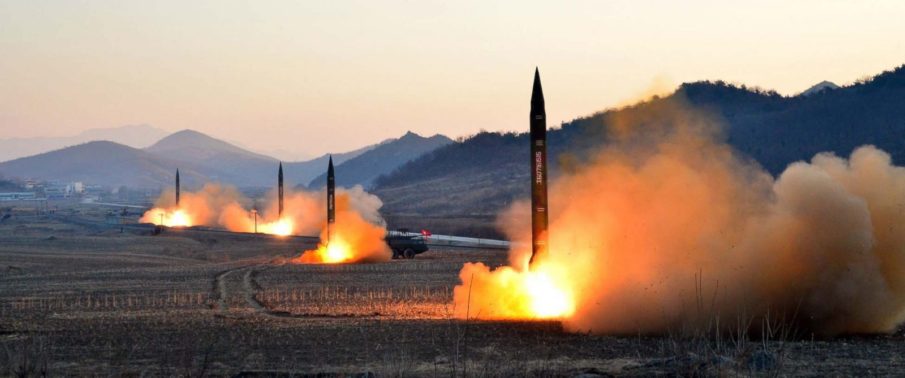Only hours after the newly elected South Korean president announced his decision to halt the further deployment of THAAD anti-missile defense platforms in his country, North Korea conducted yet another ballistic missile test. This latest test saw four ballistic anti-ship missiles launched from North Korea’s East Coast. They traveled approximately 124 miles before crashing into the Sea of Japan.
“North Korea fired multiple unidentified projectiles, assumed to be surface-to-ship missiles, this morning from the vicinity of Wonsan, Kangwon Province,” the South Korean Joint Chiefs of Staff (JCS) said, according to the Yonhap News Agency.
North Korea’s decision to fire ground-based anti-ship missiles into the Sea of Japan (also known as the East Sea) should likely be considered a message intended directly for the United States Navy, who currently has two carrier strike groups in the waterways surrounding the Korean peninsula.
“We assess that North Korea intended to show off its various missile capabilities, display its precise targeting capability, in the form of armed protests against ships in regard to US Navy carrier strike groups and joint naval drills,” Roh Jae-cheon, a spokesman for South Korea’s Joint Chiefs of Staffs told reporters.
It is currently believed that the missiles launched on Thursday morning were a different platform than seen in previous ballistic missile launches conducting by Kim’s regime. They are, however, believed to have been displayed in April’s “Day of the Sun” parade that celebrated the birth of Kim Jong Un’s grandfather, Kim Il Sung.
What appeared to be a new type of land-to-ship missile equipped with four launching canisters was unveiled at the parade,” said Kim Dong-yub, a military expert at Kyungnam University’s Far Eastern Studies in Seoul. “I think this might be what was used today.”
It is important to note that, unlike many of the missiles previously tested by Kim’s North Korean regime, these anti-ship missiles are traditionally seen as defensive in nature. Unlike Kim’s pursuit of an ICBM (Intercontinental Ballistic Missile), which can be seen potentially as a “first strike” weapon, ground based anti-ship missiles are used to defend a nation’s coastline against the encroachment of another nation’s Navy.
North Korea likely wanted to show off its ability to precisely target a large warship, in relation to the joint military drills involving U.S. aircraft carriers,” Roh Jae-cheon, South Korea’s Joint Chiefs of Staff spokesman, told a media briefing. “By testing different types of missiles, North Korea also appears to be aiming to secure the upper hand in relations with South Korea and the United States.”
Of course, because the United States Navy has served as the primary show of force tied to the international effort to dissuade Kim’s pursuit of those “first strike” capable weapons platforms, to include nuclear warheads to be placed on them.
South Korea’s President Moon campaigned on a platform that included standing up to American pressures regarding their neighbor to the North and calling for a reopening of friendly talks with Kim’s regime, despite their repeated threats of preemptive nuclear strikes on South Korean soil. The American THAAD missile defense system was declared operational days before Moon took office, but four additional platforms that were not divulged to the incoming administration were ordered halted on Wednesday, pending a full environmental study.
It seems likely that President Moon made this decision as a result of financial pressures placed on his nation, rather than out of strategic deterrence of a potential first strike. Chinese citizens have begun boycotting South Korean businesses and tourism into the nation as a result of the THAAD placement, which the Chinese believe could be used as a means to spy on military equipment placements within the Chinese borders.
Already have an account? Sign In
Two ways to continue to read this article.
Subscribe
$1.99
every 4 weeks
- Unlimited access to all articles
- Support independent journalism
- Ad-free reading experience
Subscribe Now
Recurring Monthly. Cancel Anytime.
Even China’s official daily newspaper, the Global Times, seems to assume this decision was an economic one, or at least a result of political pressures placed on Moon by the Chinese government.
Obviously, the pressure China puts on South Korea has taken effect. Seoul’s will has been shaken,” the Global Times said in an editorial on Thursday. “However, attitude is not everything. Without solving the problem of THAAD, the pain it has brought to bilateral relations will not disappear, and South Korea must swallow some of the bitter results.”
Although North Korea has yet to make a formal statement regarding these recent launches, they did make at least one threat to an American ally in the hours preceding the launches:
“If Japan is concerned about its security, it should not act (as) a poodle of the US but withdraw its hostile policy toward the DPRK and remove the US military bases for aggression (sic) from its territory,” the statement said.
Thursday’s launch marks the fourth North Korean missile test in a month, and their tenth this year.
Image courtesy of Getty Images











COMMENTS
You must become a subscriber or login to view or post comments on this article.